

How To Create the Perfect Cruising Catamaran Layout
As an Amazon Associate, we earn from qualifying purchases. We may also earn commissions if you purchase products from other retailers after clicking on a link from our site.
More than ever before, sailing fans are gaining an interest in catamaran layouts and designs that define performance. Many others are also looking into either buying a cruising catamaran or designing and building one. While building a catamaran is no piece of cake, this article shows you how to create the perfect cruising catamaran layout.
To create the perfect catamaran layout, carefully consider factors like a good hull design, optimal helm station placement, boat stability, and adequate load-carrying capacity. Excellent galley positioning, ease of handling, and spacious living and sleeping quarters are also crucial.
The modern cruising catamaran is a far cry from the simple Polynesian double canoe of old. That’s because structural innovations and new composite materials have resulted in multihulls with impressive cruising abilities. Keep reading to learn more about exceptional catamaran layouts.
The Changing Trends in Catamaran Designs
The early cruising catamaran designs resulted in boats that could sail much faster than traditional sailing boats. In addition, they could glide with ease in shallow waters and required less wind and crew. Unfortunately, these cruising cats were heavy, had small, cramped interiors, and boasted somewhat challenging handling abilities.
Today’s cruising catamarans are different. They boast the utmost comfort, high speeds, and the safety of a well-designed cruising yacht. They are also more exciting, visually appealing, deliver the smoothest of rides, and sport more spacious interiors.
Have a look at the below video showcasing the top ten cruising catamarans:
Features To Look Out for in Catamaran Design Layouts
Cruising catamaran designers understand what most sailors look for in a cruising vessel. They, therefore, design cruising multihulls that address these pertinent issues and more. Some of the features you might want to consider having in your dream boat include the following:
- Responsive performance. Outstanding performance allows for pleasurable cruising and ensures your safety since you have more options during difficult weather.
- Excellent load-carrying ability . This allows you to have an extended cruising vacation or ocean crossing.
- Boat stability . Go for lightweight, robust construction, which results in a lot of buoyancy.
- A low center of gravity for smooth rides and enhanced performance. Centering weight around a low center of gravity improves the overall sailing quality, reduces pitching movement and reduces the risk of capsizing .
- Adequate bridgedeck clearance to reduce slamming and provide better performance in rough conditions. A high bridgedeck also means less noise and slapping action from the waves hitting the boat bottom, thus ensuring a quieter, smoother ride.
- Comfortable sailing. To enjoy a quality life on board, you need comfort while at sea. Thus, elements like gentle movement, no creaks or groans, no bridgedeck slamming, and minimal pitching are essential for quality, peaceful and restful sleep.
Now that you know what a cutting-edge catamaran features, let’s look at how to create the perfect cruising catamaran layout.
Build a Larger-Sized Catamaran
The early catamarans ranged between 36-42 feet (10.9-12.8m). At the time, this appeared to be a good size in terms of safety and ease of handling. However, the boats were heavy, and the additional drag and displacement adversely affected their performance and windward ability.
It’s now possible to make the new generation catamarans lighter, larger, and more spacious with excellent power-to-weight features. The current trend is larger-sized catamarans in the 45-50 feet (13.7- 15.2) range. Composite engineering and technologically advanced equipment such as furling systems, electric winches, and autopilot make it easier for a smaller crew to sail larger boats with confidence. And to do so without compromising safety or stability.
Get the Best Catamaran Hull Design
A cruising catamaran’s performance depends on three main aspects; its length, the sail area, and the boat’s weight. Long boats are generally fast. A light boat with more sail area is also faster than a heavier boat with less sail area. In other words, you can make a multihull faster by making it longer, lighter, or adding more sail.
However, there are exceptions to this rule; a boat with too much sail area is more likely to capsize if there are brisk winds. Also, if the boat’s design makes it too light, it’ll be unable to handle much punishment, while a hull design that’s too slim would make the vessel incapable of carrying any significant loads. But that’s not all; if the boat is too long or too large, it’ll become grossly exorbitant. Narrow hull shape might also mean smaller cabins.
Nonetheless, these three factors alone are not enough to determine a cruising catamaran’s performance. While faster boats boast finer hulls, the wetted surface area tends to increase as fineness increases; thus, fine hulls end up becoming less fast in low wind speeds. Also, very wide hulls mean a reduction in actual performance.
The Prismatic Coefficient (Cp), a measure of how full the ends of the hull get, is the most essential design hull shape factor for any catamaran. A high Cp equals high speeds, although you can still use a lower Cp if you have fine hulls. Nevertheless, the key to a good Catamaran design is a higher Cp for fast sailing.
To achieve a high Cp, there are several things you can do:
- Fit bulb bows . Unfortunately, the bulb bows tend to slam in a seaway when you do this.
- Have an extensive planning aft section . However, this can increase the wetted surface area, WSA and lead to additional challenges.
- Flatten out the hull rocker and add a bustle aft. This helps to add displacement aft.
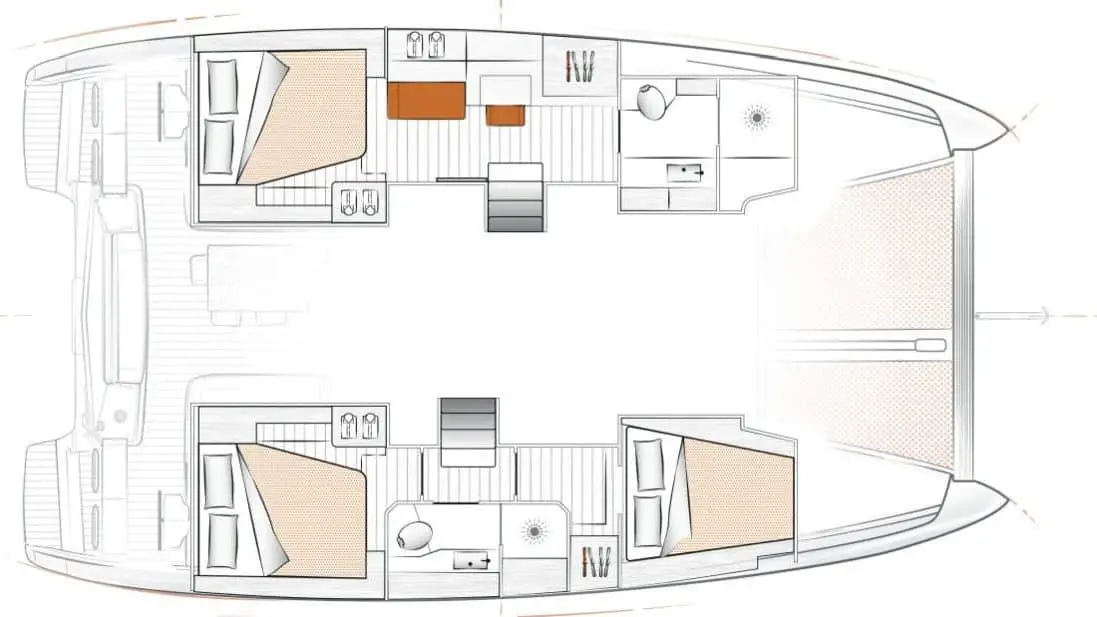
Build Convertible Main Living Spaces
The open cockpit is now a thing of the past. Instead, pioneering designers for catamaran manufacturers like Nautitech, Gunboat, and Catana now replace traditional-style salons, cockpits, and cabins with spacious indoor and outdoor living spaces. The concept involves merging separate saloon and cockpit areas with duplicate lounge spaces and the use of hard-wearing composite materials.
You can also design the cabin to suit your preferences. You may decide to add a cabin or remove one, add a bathroom, have the forward berth in the hull or on the wing deck.
- The design enhancements boost usable space while opening up the living areas.
- It reduces time and costs for interior maintenance and cleaning.
- Large windows bring in more light, increasing visibility.
- Luxurious, spacious, and airy owners’ cabins provide more comfortable living space.
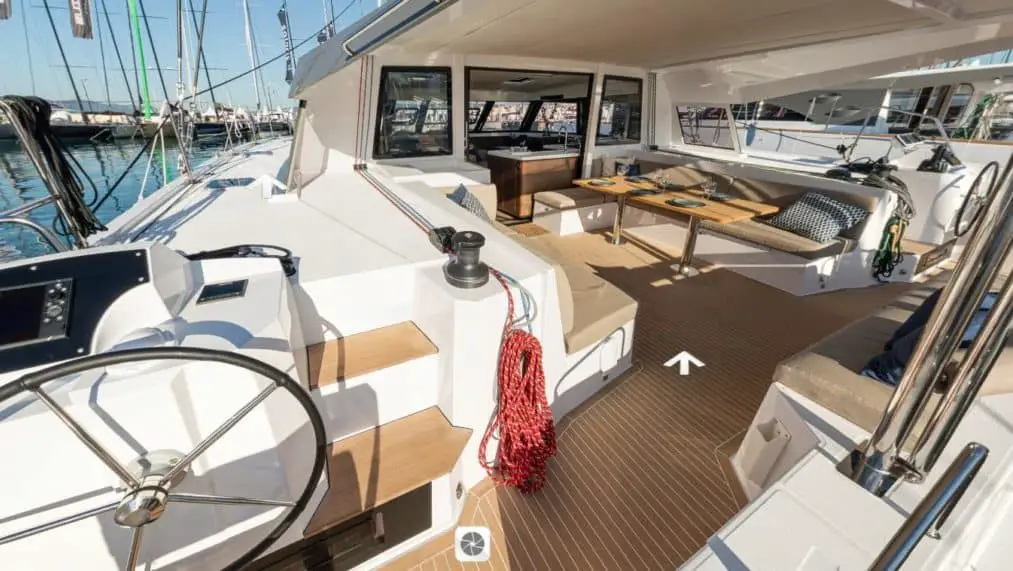
Bulkhead Helm Stations vs. Twin Stern Steering
Many catamaran owners have traditionally preferred bulkhead steering. This helm position remains popular, but twin stern steering positions come with more advantages since they provide greater sails visibility. The twin stern positions are also best suited for racing or day sailing since they often lack adequate protection for extended cruising.
Exposed helms are not ideal for a long ocean passage. Go for a safe, secure, and well-protected helm station that provides good visibility and comfortable space for long watches. Again, it’s best to have all control lines at the helm to establish a static control station. Also, have all push-button-controlled winches, instruments, windlass, and autopilot prominently located inside the cockpit.
- Twin stern steering positions give you a better view of the sails
- You get a better feel for overall sailing conditions.
- Twin stern steering positions lack the necessary protection for extended cruising.
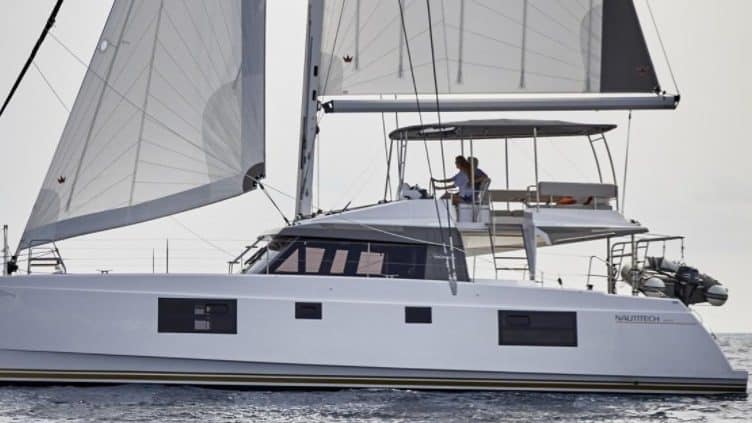
Go for the Flybridge Design
The flybridge design is appealing because it offers excellent visibility, more comfort, and additional entertainment and lounging space for everyone on board. Unfortunately for smaller boats – those below 50 feet (15.24m), there is minimal protection from the elements. As such, you might want to consider adding enclosures to offer protection. The flybridge, thus the helm, remains cut off from the vessel, which makes communicating with the crew a challenge.
- It provides great visibility.
- It offers comfortable spacing.
- It might be unsafe to move from the cockpit to the flybridge in bad weather.
- It isn’t easy to communicate with the crew.
Daggerboards vs. Fixed Keels
Average cruising catamarans typically utilize fixed keels while high-performance cats have daggerboards . Fixed keels allow you to beach your catamaran easily, and your hull remains intact if a collision occurs. While you lose some angle when sailing upwind, you gain more interior space in the hulls that you can put to good use.
Daggerboards are essential in a performance cruising catamaran since they guarantee that the boat delivers good upwind sailing, including during difficult situations. During long passages, they allow you to point better upwind though the drawback is that they consume much interior space within the cruising catamaran’s hulls.
Since flying on foils ( hydrofoils ) isn’t that practical on cruising catamarans, designers of larger-sized boats have also come up with modified daggerboards. These daggerboards produce lift and prevent leeway, too, thereby improving performance significantly, as seen with the Catana 59’s curved daggerboards. These foil-like daggerboards lift the boat ever so slightly upon reaching higher speeds, making it feel less heavy and much faster.
At the end of the day, calculating the performance of a boat sailing in a wide range of varying seas and winds might not be easy – despite a daggerboard or fixed keel configuration. This is because upwind speed depends not only on the sails’ quality but also windage and the height of the bridgedeck beyond the water.
- The design innovations -curved daggerboards and hydrofoils- improve catamaran performance significantly.
- Daggerboards enable you to access otherwise inaccessible anchorages.
- Daggerboards take up hull space in the hulls of your vessel.
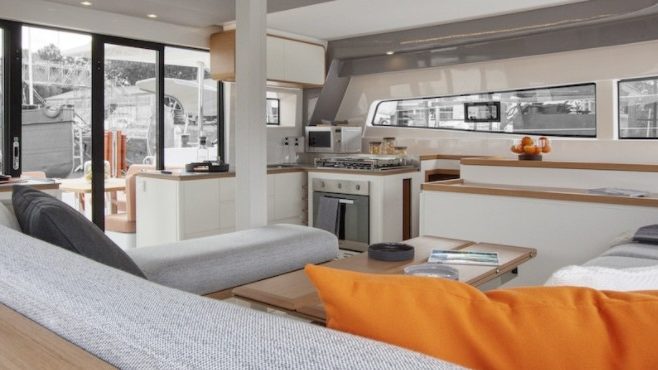
Galley Up vs. Galley Down
Galley layout are becoming more and more important as more people, including families, start sailing regularly. While at sea, your galley needs to be a safe place, well-ventilated, and functional. Everything should be well-thought-out for the sailor’s comfort, including handholds to make it safer to move around the boat.
While the galley location can either be up the bridgedeck or down in the hull, galley up appears to be the most popular trend. This makes the galley the focal point of both the living space and entertainment areas.
If you have a family, this placement is ideal since you make your meals from the galley and get to spend most of your time here. Many cruising families and couples prefer this arrangement and find separating the galley down the hull unappealing. Besides, carrying hot food up and down the staircase is unsafe.
Still, galley down is ideal for charter boats since it offers a private cooking area and uses up hull space efficiently.
- Having the galley on the bridgedeck is ideal for families and cruising couples.
- Placing the galley on a similar level with the serving area and cockpit is safer and less tiring.
- There’s better ventilation on the bridgedeck, making for comfortable cooking.
- There’s less kitchen privacy galley up.
- On smaller catamarans, this layout can impact the size of the saloon seating area significantly.
Production Catamaran vs. Custom
The choice of either a production catamaran or a custom design might seem pretty straightforward. Production catamarans from major brands come backed by proven designs, dependable construction, solid warranties, and many years of experience. The catamarans are easy to service, source for parts, and most – particularly the owner’s versions – hold on to their value, making them much easier to resell.
On their part, custom boats are fantastic in that you can tailor them to your exact needs. However, they might be more challenging to maintain or service. That’s because of parts unavailability and lack of construction knowledge.
Choose Quality Construction Materials
The best quality materials to use on your catamaran are both light and robust. While carbon fiber is great, plywood, plywood/epoxy, and strip-cedar are excellent materials too. What’s more, they are also affordable, so you don’t have to get too hung up on cutting-edge building materials. What matters is build quality; thus, a well-built plywood catamaran boat can last as long as a boat made from more high-tech materials.
Combining various materials also helps combat some of the issues that plague plywood boats in terms of resale value. At times, the design tends to make the boats appear pretty dated.
- Plywood and strip-cedar materials are affordable and provide excellent build quality.
- Plywood boats may have a lower resale value than those built with modern materials.
Consider Ease of Handling
An important factor in handling a cruising catamaran is deck layout. Most cruising catamarans sailed short-handed , so if your boat has one helm, all lines should run back here to allow for a static control station for the entire boat.
The other essential element is visibility from the helm. The 360 degrees of visibility while maneuvering, docking, or underway is crucial to your boat’s safety, as well as life and property. As such, you should be able to view both bows, or at least the pulpits and sterns, while standing at the helm. If not, you may have challenges handling the boat due to blind spots.
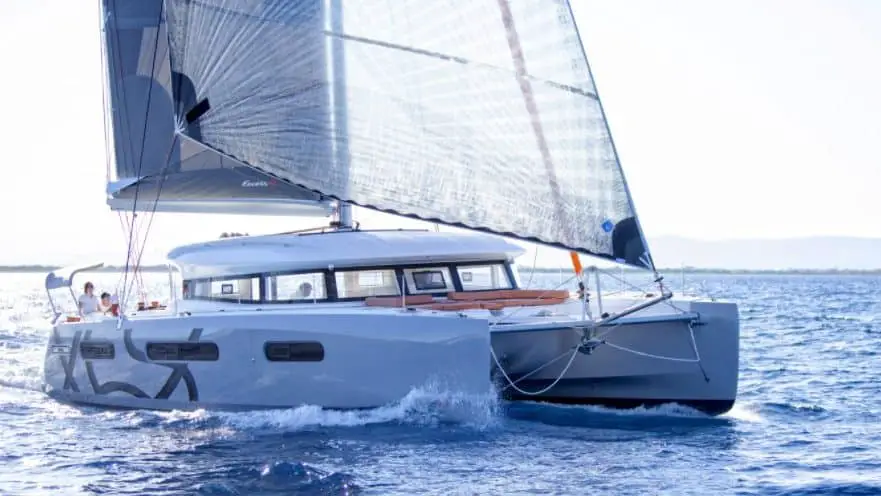
Consider the Load Carrying Capacity
A well-designed catamaran is enjoyable to sail in all weather conditions. It’s also much easier to handle than a monohull because of its widely spaced twin engines. But when you immerse extra hull depth, the vessel gets sluggish and moves slower, maneuvering in tight spots or when docking becomes more challenging. Furthermore, the hull submersion reduces bridge deck clearance, leading to hull slamming.
To allow for adequate load carrying capacity, you need a design that provides a generous displacement. This helps to ensure that you maintain reasonable bridge deck clearance even when fully loaded. It also allows you to avoid digging big holes in the water as you drag your transoms.
Displacement refers to the amount of buoyancy designed into the hulls, which essentially means that your boat will cruise better if its weight is less than your designed displacement.
Note that an overloaded catamaran not only loses out on performance but eventually, on safety too. To counter this, choose a lightweight catamaran with hulls bearing cored construction and interiors made of lightweight materials.
Remember, when you go cruising, you will need to carry fuel, extra water, supplies, equipment, and amenities, translating into thousands of extra pounds. Therefore, try and avoid the following design errors to ensure that your catamaran has an adequate load-carrying capacity:
- Avoid putting in place too much accommodation space.
- Avoid building a heavy boat ‐ use low-tech construction materials.
- Avoid installing inboards in a small boat.
- Lightly constructed catamarans perform faster and carry more weight.
- Cored construction makes for a strong and stiff catamaran, thus enabling good performance.
Final Thoughts
A well-designed cruising catamaran is a joy to behold. Today’s modern technological advancements mean that you can buy or build a light but strong cruising catamaran. And as you can see from this article, there are many excellent cruising catamaran layouts that you can choose from.
However, whichever layout you decide on needs to fit your sailing needs and purposes to ensure you remain comfortable and safe while at sea. Above all, ensure that you go for a vessel that you can handle with ease in all weather conditions.
Owner of CatamaranFreedom.com. A minimalist that has lived in a caravan in Sweden, 35ft Monohull in the Bahamas, and right now in his self-built Van. He just started the next adventure, to circumnavigate the world on a Catamaran!
Leave a Reply Cancel reply
Your email address will not be published. Required fields are marked *
Save my name and email in this browser for the next time I comment.
Recent Posts
Must-Have Boat Gear for Catamaran Sailors!
Sailing is probably the most gear-intensive activity I've ever done; there are so many decisions to be made about what gear to buy now, for tomorrow, and what to definitely never buy. The gear on...
6 Best Trailerable Trimarans For Bluewater and Coastal Sailing
Having a boat costs a lot of money, even when you are not using it, marina fees, etc. And once it is in the water most sailors never go very far from their "home marina" and sailing will be somewhat...

MIKE WALLER
Yacht design.

WE SPECIALIZE IN BOAT PLANS FOR AMATEUR BUILDERS
We provide stock boat plans for both monohull and multihull sailing vessels, including sailing skiffs and sharpies. Our designs mainly feature timber construction, in plywood or cedar strip plank composite construction, using the W.E.S.T. system (wood epoxy saturation technique). Our designs are intended mainly as cruising boats, although several have done well in racing. All designs are suitable for amateur boat builders.

MONOHULLS
multihulls , photos from our builders.
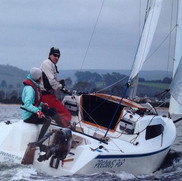
Photo galleries are provided on each design page where available
Did You Know That We Offer Contract to Closing Services? Click Here to Find Out More.
Need Marine Financing? Apply Here With Our Partner, First Approval Source
- Catamaran Interviews
- Catamaran Reviews
- Buying Advice
- Selling Advice
- Woods Design Advice
- Americat 3014
- Aquila 44 Yacht
- Balance 526
- Bali 40 Catspace
- Beneteau Blue II
- Broadblue 346
- Broadblue 38 Prestige
- Broadblue 385
- Broadblue 435
- Broadblue 46
- Catalac 10M
- Catalac 11M
- Catalac 12M
- Catalac 900
- Catana 42 S
- Chris White 48 Voyager
- Chris White 55
- Corsair F28 R
- De Villiers
- Dolphin 460
- Endeavour 30
- Endeavour 35 Victory
- Endeavour 36
- Endeavour 44
- Endeavour 44 TrawlerCat
- Fortuna 36 Island Spirit
- Fortuna 401 Island Spirit
- FP 32 Maldives
- FP 35 Tobago
- FP 37 Antigua
- FP 38 Athena
- FP 39 Fidji
- FP 40 Lavezzi
- FP 40 Lucia
- FP 40 Summerland MY
- FP 41 Lipari
- FP 42 Astrea
- FP 42 Venezia
- FP 43 Belize
- FP 44 Helia
- FP 44 Orana
- FP 46 Bahia
- FP 46 Casamance
- FP 48 Salina
- FP 56 Marquises
- FP 57 Sanya
- FP 60 Eleuthera
- FP Saona 47
- Gemini 3000
- Gemini 3200
- Gemini 3400
- Grainger 420 Mystery Cove
- Hirondelle 7M
- Lagoon 37 TPI
- Lagoon 42 TPI
- Lagoon 43 PC
- Leopard 39 PowerCat
- Leopard 45 Classic
- Leopard 47 PowerCat
- Leopard 51 PowerCat
- Leopard 53 PowerCat
- Maine Cat 30
- Maine Cat 41
- Matrix 450 Vision
- Matrix 760 Silhouette
- Maverick 400
- Maverick 420
- Maverick 440
- Nautitech 40
- Nautitech 442
- Nautitech 46 Open
- Nautitech 47
- Outremer 40
- Outremer 45
- Outremer 50 Standard
- Outremer 55
- Privilege 37
- Privilege 39
- Privilege 42
- Privilege 43
- Privilege 435
- Privilege 45
- Privilege 465
- Privilege 48 Transcat
- Privilege 482
- Privilege Serie 5
- Prout 31 Quest
- Prout 33 Quest
- Prout 34 Event
- Prout 35 Snowgoose
- Prout 37 Snowgoose
- Prout 37 Snowgoose Elite
- Prout 38 Manta
- Prout 39 Escale
- Royal Cape 45
- Royal Cape 530 Majestic
- Royal Cape Majestic 500
- Sailcraft 30 Iroquois
- Sailcraft 32 Comanche
- Sailcraft 35 Cherokee
- Sailcraft 41 Apache
- Sailcraft 44 Apache
- Wildcat 350
- Seawind 1000
- Seawind 1160
- Seawind 1200
- Seawind 1260
- Seawind 1600
- Solaris 36 Sunrise
- Solaris 36 Sunstar
- St Francis 44
- St Francis 48
- St Francis 50
- Stealth 11.8
- Heavenly Twins 26
- Ocean Twins 38
- Voyage 380 Maxim
- Voyage 400 Norseman
- Voyage 430 Norseman
- Voyage 450 Cabriolet
- Voyage 47 Mayotte
- Wharram 38 Tiki
- AMI 320 Renaissance
- Woods 22 Wizard
- Woods 35 Banshee
- Woods 35 Flica
- Woods 36 Scylla
- Woods 36 Vardo
- Woods 38 Transit
- Woods 40 Meander
- Xquisite X5
- Xquisite X5+
Catamaran Structure – Bridge Decks and Cross Beams
- Post author By BJ Porter
- Post date April 30, 2021
- 6 Comments on Catamaran Structure – Bridge Decks and Cross Beams

Editor’s Note: Many thanks to Ted Clements of Antares Catamarans and Shane Grover of Seawind Catamarans for patiently answering our questions.
There are a lot of reasons why catamarans are more expensive than monohulls. It’s not just the two hulls. There are many more complicated calculations and structures needed to build the complex shapes.
Building a bridge deck and the structures around a pair of hulls is a lot more difficult to design and build than a single hull, and we’ll explore a little about why.
Part 1: Forces on the Hulls
Load and force calculations on a boat hull isn’t a simple calculation, and even monohulls take a lot of designing to build a shape which performs well and has the strength to hold together at sea. Land vehicles have fairly predictable forces and motion on them, but boats can take forces and stresses in any direction.

Waves slam from all directions, boats plunge off waves and get smacked around in chop. Wind forces stress masts and rigging, which applies bending moments and forces to chain plates and the hull. Hulls flex and bend with this motion, and even from tensions applied to the rig.
Elements of drag, hull shape, keel shape and rig design all factor in, whether it’s a heavy, stiff cruising boat or a light, high performance racing machine. Those forces have to be figured, and materials and constructions are made to suit the conditions and situations where the boat will sail.
And that’s just a single hull. When you add a second hull to mix, you add in a whole new set of loads.

Bananas and Pencils
To illustrate these additional loads, we’ll do a thought experiment with a couple of household items. You can try it for real if you want to – but you’ll need two bananas and a few pencils.
Start with the bananas laying parallel to each other, then run a single pencil through the midpoint of each banana (the hulls) to connect them. They’re connected, but when you pick it up, what happens? They don’t stay parallel, of course. We need a second pencil or even a third one, to keep them in place.

The pencils are the crossbeams you’ll hear about in catamaran construction. If you put two of them through the bananas to connect them about 1/3 of the way from the end of each banana, you’ll get a fairly stable platform (for something made from soft fruit and pencils).
Imagine picking up this banamaran with two crossbeams with one hull in each hand. How can we still move the hulls?

First, we can twist one half back and one hand forward, putting lots of force on the crossbeams. To stop this, we could use much stronger beams, and we could put more beams at the ends of the bananas.
If you rotate your hands and the bananas, you demonstrate another type of force on the crossbeams. Pushing the bows or stern together also can move the hulls.
Building the Boat
Now imagine putting weight on the pencils – you’re adding the bridge deck. The mast sits on the bridge deck and creates additional loads and stresses on the crossbeams and hulls.

Finally, we add a sailing rig on top of the weight on the pencils. The rig needs support to stay up. On a monohull, stays run to the bow and stern to support the rig. But a catamaran the mast is centered between the hulls. The tension on the rig will provide upward pull on the hull shapes and usually attach to bow crossbeams. So we’re now pushing down on the middle of the bananas while pulling up on the tips.
The challenge to the catamaran builders and designers is to account for all these forces and build a pair of hulls capable of absorbing these loads without breaking or separating the hulls.
Part 2: Crossbeam Design
Catamarans are not new concepts; double hulled sailing canoes were used in Polynesia and Melanesia long before European explorers arrived. One of the first recreational catamarans was designed and built in 1876 by Nathanael Herreshoff and sailed well enough that the New York Yacht Club banned multihulls from racing.

Most beams are hollow to save weight in increase strength for the amount of material used. A hollow cylinder or rectangular tube gives more resistance to bending per pound of material than a solid rod of the same weight. There are mathematical explanations beyond both the scope of this article (and my ability to explain), but it’s important to know where the loads on beams are supported to understand this.
Greatly simplified – bending a beam creates compressive loads. The further from the center of the beam, the higher the resistance to compression. A rod will have a narrow diameter and resistance is lower. But if you make a cylinder or square tube from the same amount of metal (or fiberglass) you will have the same cross-sectional area, but the compressive force is applied further from the center of the cylinder.
Think of an I-beam from building construction. The compression is on the sides of the I-Beam, but the part in the middle is mostly to keep the sides in place, not bear the load on the beam in high stress applications.
Original Beams
A close look at these boats shows clear and obvious crossbeams connecting the hulls. Duplex , the early Herreshoff boat, had three clear crossbeams and a cockpit on the aft two between the hulls.

Smaller beach and racing cats will have obvious crossbeams, since the decking is usually a stretched piece of canvas or webbing. Other open bridgedeck catamarans, including many home builds, may have actual beams across them holding the hulls in place. And most cats will have some sort of beam across the bows as well.
But when you look at modern bridgedeck catamarans, you notice something strange about the beams. There aren’t any actual “beams” built into the boats.

Modern Cruising Cats – There Are No Beams
It’s more you notice something missing about the beams. Modern bridgedeck catamarans don’t generally have actual crossbeams built into them, as if you were glassing a beam or post into the boat. Instead, the construction of the boat is built around a design the provides the mathematical equivalent of a “beam.”
Bear with me. It took a while for me to get my head around this, too.
Picture a box – even a simple shoebox has rigidity to its sides. Yes, you can crush it, but the hollow sided box offers a lot more stiffness than a piece of cardboard on its own. The structure of the beams is in essence a box built between the hulls, with super strong modern laminate materials providing stiffness to take the loads and stresses.
When modern cats are designed, the “crossbeam” is a combination of internal structures built and connected to the bulkheads that create the load bearing capabilities of a hollow beam section. So the “beam” exists mathematically in the designer’s wireframe drawing of the boat, but when it is built, it is not an external beam added to the structure, but rather a set of structures that act like a beam because of their physical design.

Developments in materials technology over the last few decades allows for shapes and strengths that couldn’t be built with traditional materials like wood or metal.
Part 3: Building a Bridgedeck
Building the bridgedeck is the key piece of fiberglass catamaran strength. To be able to build a boat which can handle all these twisting and torsion forces, creating that “box” to add the strength, catamaran builders take one of several approaches. All can be effective and meet the design requirements, but there may be other reasons a builder chooses a particular approach.
“Tooling” refers to all the molds needed to shape a fiberglass hull. Tooling can be made from a number of different materials and represents a significant investment for any new production catamaran. Costs can run to many millions for tooling durable enough to build a hundred or more boats without changing design and build tolerances.

Molding and tooling to build hulls is a major expense, no matter which approach a builder takes. Building tools and molds can run into millions of dollars in expenses for materials and labor, and molds built for production runs of boats are considerably more expensive than tooling for a one-off or unique design. All of these factors into the decision making behind a build process.
Building a multihull also presents unique challenges compared to building monohulls. Building a single hull can be a fairly linear process – the hull is laid on the mold and built, the inside is fitted out, and decks are attached. While that’s a simplification of the process, it is relatively straight-forward because there is only one hull.

For catamarans, the integral bridgedeck structure doesn’t lend itself to a step-wise assembly. The crossbeams and bridgedeck need to be built integrally before the interior and decks are completely finished. For the builder, this means some parts of the boat have to be finished with reduced access to interior sections of the boat. For the designer, the challenge to is to make the boat so the builder can build it efficiently. For production vessels with build runs in the hundreds, cost effectiveness and production efficiency is crucial.

Not only does the bridgedeck hold two hulls together against all the twisting and torsion forces we’ve discussed, it also has to carry cargo. It holds the living space in the main saloon, as well as passengers and equipment.
Think back on the shoebox – it has compressive strength from the ends, but any individual side is fairly weak. You can deflect the sides easily. While this is fine on a shoebox, it would be disconcerting if the deck flexed and bounced when you walked across it. The bridgedeck also needs strength from the top and bottom to take this load in the central parts of the boat, away from the “box.” You can’t just make the decks and floors massive, that sacrifices headroom and internal volume. Instead, internal structures and stiff construction materials have to take up the load.
Two Piece Molding
Some builders build two hulls individually. One mold can be used if the hulls are identical, and the hulls joined later in the build process. Like any design and build decision, there are pros and cons for the builder which can affect the cost of the final product. If built correctly, there are no compromises in strength from a one piece mold.

For the builder, a one piece mold is much easier to handle. Any hull built on a mold will have to be removed from the mold once the hull is laid, and a single mold is smaller, lighter, and narrower. Breaking a hull out of a mold is a complex process, and may involve cranes and heavy equipment to support the hull as it comes of the mold and to protect the tooling from damage. To remove a hull, you need space to lift the mold and to get heavy equipment around the tooling. And you’ve got to put the molds some place when it’s done.

Connecting two hulls precisely once they’re molded is a more complex task. Unidirectional fibers bond key structures to bulkheads to build the support “box” making up the crossbeams. Although a one piece mold will give an inherently stronger single-material connection between the hulls, more than sufficient strength can be built in with advanced fiber and resin choices (such as carbon fiber and epoxy) when then build the deck connection.
One Piece Molding
Most production catamaran builders have moved to one piece molding. A single tool is built to lay up both hulls and the bottom of the bridgedeck connection in a single large piece. The fundamental strength of the build is higher, allowing for less expensive materials to get the same strength.
“One piece” is a slight misnomer, as the top of the hulls and decking is built in a second mold which is laid over the hulls and bonded along the joint near the top of the hull molds. The loads on a join between the bottom hull and top deck are considerably lower than those on the bridgedeck. There’s no real twisting and torsion on that part of the boat relative to the join between the hulls, so it can be laminated without the same concerns as building between the hulls. ( Editor’s Note: Some builders mold the bridgedeck and inboard half of the hulls together and then mold on the outboard halves of the hulls and deck on top. There is a seam running stem to stern centerline along the bottom of each hull with this technique. )

There are a number of production and build advantages to this approach. Though the tooling is larger, more expensive and awkward, the lay up process incorporates the core hull joins in the initial build. You don’t have to line anything up and glass it in place when your hulls and deck are built connected. There isn’t need for as much material buildup to shore up the “box” since it’s part of the integral build.
Fitting the interior joinery and finish is more challenging, since the crossbeams and related components must be built early in the process. Extra care and planning in the design process can make this more efficient, but access to internal areas of the hull can be difficult during the build.

Alternative Materials – Wood and Metal
Composite construction – fibers and resin – lets builders make nearly any shape. Fiberglass has allowed for the wide range of affordable to high end production catamarans available today. Stronger fibers and better resins have only expanded the possibilities for light, fast, and strong boats.

Wood is rarely used for structural elements in modern production catamarans. It can be heavy, and it doesn’t lend itself to the complex molded shapes designers demand for optimal strength and seaworthiness. Plywood may be used for stiffening in places, and balsa cored decks may still be found. But mostly in older boats, home builds, and kit boats.

Metal construction has its own problems, and very few catamarans are built from metals. Curved shapes are difficult with metals; bending a smooth radius into a flat sheet without bending it, then welding it into place requires time and skill. And weight will be a problem. On the whole, fiberglass is a better solution for a light, strong catamaran.

Conclusion: Tying it Together
This overview only touches on some of the challenges multihull builders face, which monohull builders do not. But what does it mean for you when you’re looking at catamarans to buy? All the fiberglass build techniques will result in a strong boat if built properly. There may be differences in the amount of materials used, and choices for resins and fibers, but the boat should be evaluated as a whole.
It’s good to understand how your boat is built, and to be aware of some of the strengths and limitations of each build technique. But no build technique is inherently better or worse than the other – no matter how your next boat is built, the designer and builder will ensure the build is up to the task.
- Tags Buying Advice

By BJ Porter
Owner of Hallberg Rassy 53; world explorer.

6 replies on “Catamaran Structure – Bridge Decks and Cross Beams”
Proof read much? But the no build technique is inherently better or worse than the other… Good article spoilt by miss spellings and errors.
I corrected the extra “the” you mention in that sentence. I do not see other errors. We do our best and thank you for reading and commenting.
Great article. Very informative for us non-technical types. Great use of graphics and photos to explain the various torsion forces and different build methods. What is the purpose of the wing-like, rear spoiler-looking feature that you sometimes see spanning across the back of the deck/bridge and sometimes connecting the two hulls?
It doesn’t actually connect the hulls, it rests on them. In the good old days this was named a “RADAR Arch” and was used to mount the RADAR antenna and dinghy davits.
Over the last 20 years this stern “ARCH” became a very convenient spot to mount RADAR, solar panels and it is in this role it serves very well while also handling various antennas and of course, the dinghy.
Thanks for the article, great stuff, very informative and useful info. Kudos
I’m actually researching and trying to figure out how to build my own catamaran. But information is very hard to find.
Leave a Reply Cancel reply
Your email address will not be published. Required fields are marked *
Save my name, email, and website in this browser for the next time I comment.
This page is currently unavailable
HOME / INDEX PAGE
Catamaran Design Guide
Spectacular sunsets in the Pacific turn the horizon into a brilliant spectrum of gold and orange colors.
Copyright © 2006, 2008 by Gregor Tarjan. Click here for terms of use.
performance, yet desire high daily averages and passage times, which should be as short as possible. When choosing a large multihull, sailors look, above all else, for safety and comfort, long before the consideration for flat-out speed comes into the discussion. Nevertheless, performance is a highly important design consideration. No catamaran sailor wants to sail slower than a same length ballasted keelboat. Below are some EVALUATION & COEFFICIENTS useful coefficients, which will help compare monohulls and multihulls objectively.
Bruce Number (BN)
below "Indigo," a magnificent Wormwood 70, sailing in sparkling Caribbean waters.

Various multihull characteristics and design features can be expressed in mathematical formulas. Their results are crucial and will give prospective owners a basis of comparison between different types of catamarans. These numbers are important, as they eliminate ambiguity and clearly display various advantages or concessions of a design, which would be hard to quantify any other way. Mathematical coefficients not only will provide insight into a boat's performance in varying conditions, they also reflect concerns about loads to be carried safely, speed and stability.
We have already mentioned the Displacement/Length and Sail Area/ Displacement ratio in our chapter on Multihull Advantages, illustrating the point of a multihull's efficiency. Let's look at some other coefficients that give us an indication of a boat's performance.
What is performance and how do we really measure it? Most people who buy a cruising catamaran are not really interested in racing
The Bruce Number is very similar to the Sail Area to Displacement ratio although the formula is slightly different. It is the square root of the sail area in feet, divided by the cube root of the boat's displacement in pounds:
SA = upwind sail area (mainsail and 100% jib)
Displ = weight of the boat in pounds
Similar to the Sail Area to Displacement ratio, the higher the coefficient the faster the boat and better is its performance in light air. Typically a BN of 1.1 will be the threshold between fast and more sluggish multihulls. A heavy displacement monohull might have a BN of .7, whereas a modern cruising catamaran shows a BN of 1.3. Offshore multihull racers can have BNs of 2.0 and higher. The BN will also tell us about a catamaran's ability to withstand stronger winds before reefing. A boat with a higher BN is usually overcanvassed in strong conditions and will have to be reefed earlier than one with a lower coefficient.
On the other hand, they will be able to produce more "power" than their counterparts in lighter winds and perform better.
Sail Area to Wetted Surface (SAWS)
SA/WS = Sail Area Wetted Surface Coefficient
SA = upwind sail area
WS = total underwater surface area (hull and appendages)
This formula simply divides the upwind sail area of the boat (mainsail and 100% jib) by the wetted surface. This coefficient will give us a statistical indication of the multihull's lightair performance since in low wind conditions skin friction becomes an important factor. Monohulls can have coefficients of at least 7% more than multihulls.
Hull Fineness Ratio (HFR)
The Hull Fineness Ratio, known as the hull's beam-to-length ratio, is an interesting number. It is derived by simply dividing the waterline length of the hull by the waterline beam of the hull.
Max. WL/Max. Beam WL = Hull Fineness Ratio Max. WL = length of the hull at waterline in ft. Max. Beam WL = beam of the hull at the waterline in feet.
Monohulls, when compared to multihulls, have low hull/fineness ratios. In Part 1 of this

book, discussing "Efficiency," we saw that ballasted keelboats are limited to Archimedes' principle of hull speed (1.34 x VWL). Multihulls do not have these theoretical barriers, because their hulls are narrower.
The thinner the hull the faster it will be able to travel through the water. But, attention! It will also carry less unless you are on a mega cat. Typically, a 40' cruising catamaran's HFR will range from 8:1 to 10:1. Dennis Conner's above While sailing under spinnaker and experiencing virtually no roll at all, guests will always find a comfortable spot to relax on the foredeck, an impossibility on a monohull.
There are various methods of calculating the transverse stability of a catamaran. One of the simplest and most utilized techniques is establishing a relationship between the height of the Center of Effort (CE), displacement, beam and sail area. Multihull designer, James Wharram added safety factors of 20% to compensate for gusts and the dynamic environment of the ocean. Another method is described in the text below.
Multihull Stability & Capsizing Moment d - Displacement (kg) x half beam (m) max ~ Sail Area (sq m) x Height of Center of Effort (m)
P max = maximum pressure exerted onto sails
Multihull Stability & Capsizing Moment

height of sailplan CE
half overall beam (half hull beam)
racing cat "Stars and Stripes" had a 16:1 HFR. Of course, the larger the boat, the narrower the hulls will become in comparison to its length. For example, the HFR of a 100' luxury catamaran may be 12:1, providing it with a high speed potential. However, monohulls can show HFRs of 3:1, though the comparison is complicated as their angle of heel affects the measurement.
One has to be very careful when analyzing the Hull Fineness Ratio of a cruising catamaran, because other factors such as the actual shape of the hull cross sections (Prismatic Coefficient, PC) can throw the analysis off balance. Go-fast sailors like to think that fine hulls are always fast. That is not necessarily true because a slim hull could have a large underwater volume, thus slowing it down. Consequently, a wide waterline-beam hull could have less drag than a narrower one. It could have a shallow underbody (low PC), which would be beneficial to load carrying (Pounds Per Inch Immersion Number, PPI) and early surfing characteristics at speed.
Stability Coefficient (SC)
This mathematical formula has been devised by the distinguished catamaran designer and sailor James Wharram and his team. This coefficient analyzes a multihull's ability (in a static environment) to resist capsizing due to wind.
( 0.682 VW x (.5 Boa) ) x .555 = CW .00178 x SA x h
W = Wind speed, apparent, in mph CW = Critical Wind Speed to capsize in mph SA = upwind sail area in sq ft. h = height of Center of Effort (CE) of total sail area
Boa = Beam overall
This formula will tell us how much wind it will take to overturn our multihull. By instinct we will know that a catamaran with a wide stance and a conservative sail plan will be very stable offshore. The SC formula will inevitably illustrate that a wider beamed catamaran with a tall sail plan will be as resistant to wind induced capsize as a short-rigged, narrower boat. This is not so if one considers the chaotic environment of waves and the real world of heavy weather sailing. It is interesting to note that a wide beamed boat (regardless of the SC) is more resistant to capsize in seas due to the effects of a higher moment of inertia. In an open-ocean environment, which is everything but static, the SC formula has little meaning. Nevertheless, it serves as a good basis to evaluate stability as a factor of wind force.
below When the wind suddenly comes up, all that is needed is a couple of turns on the jib furler to quickly reduce the headsail size. The catamaran will hardly sail any slower, but feel more comfortable.

Wide hulls and a large overall beam will increase the overall righting moment of a catamaran. A word of caution: Excessive beam will reduce the fore and aft stability. Designers strive to compromise hull fineness ratios, place heavy weights towards the CG (Center of Gravity), and engineer hull and overall beam to achieve a seaworthy balance, which is safe, yet provides ample liveaboard accommodations.
Catamaran Stability Considerations

Diagonal Stability & Beam-to-Length Ratio (BLR)
Stability of a multihull, or the resistance to capsize, should be seen as three components. Athwartship Stability is one well-publicized type and the one often talked about. The other much more important types are Fore and Aft and Diagonal Stability. Fore and aft stability is established by the relationship between the boat's waterline length and the distance between the hull centerlines. It will reflect the catamaran's resistance to tripping. This relationship should be in the vicinity of 39% to 42%. For a seaworthy cruising multihull it is important maintain the proper ratio between length and beam, which, in turn, balances equal amounts of athwartship with diagonal stability. The goal should be to prevent the possibility of a sudden discrepancy of powers between fore and aft and sideways resistance. Most of today's multihulls keep these two component forces in equilibrium, making them extremely seakindly and safe.
Some early design multihulls were very narrow, partly due to the material limitations of that time. But things have changed. Contemporary composite construction allows designers to build wider boats without compromising stiffness. Production catamarans of today have a wide stance and have the benefit of greater safety margins in gusty wind conditions than their older cousins. Multihulls are sophisticated structures and true modern miracles. They provide a more comfortable ride and more interior room. Thanks to modern materials they weigh less and perform better than catamarans built only 10 years ago.
Some catamarans, especially production boats, which are very popular in the charter fleets, are growing wider by the year. The businesses who rent these beamy monsters adore them. Lots of room plus open decks are ideal for clients and the bigger (wider) the boat, the more paying guests can share the fees. But there certainly is a limit as to how wide is too wide. Extreme beam can be dangerous. It can lead to instability fore and aft and to excessive bridgedeck slamming, as the relative distance from the bridge deck to the water will decrease with an increase in width. A vessel with excessive beam might seem stable athwartships, but it will compromise overall stability.
We know that multihulls can, in extreme cases of seamanship error in wild storms, be thrown over from any side - front, back and beam-on. The best examples of this phenomenon are racing multihulls, especially Formula 1 trimarans, which have fine hulls for speed and huge sailplans to provide driving power. They are initially extremely stable athwartships (High Beam-to-Length Ratio), but have a tendency to become unstable fore and aft. They will surf down waves and reach a point where the power of the sails, and speed, will exceed the ability to keep the bows out of the water and the boat will pitchpole. This is the reason why catamaran designers usually draw their multihulls with a Beam-to-Length relationship of between 50% and 55%. The longer the vessel the lower that percentage becomes.
I am currently involved in the "Gemini" project, which presents an example. It very well might become the world's largest sailing catamaran. She will have an overall length of 145 feet, yet her beam will "only" be 54.4'.

Please, don't worry. "Gemini" will not be tender and tip over in the slightest breeze. On the contrary, this monster will be one of the most stable craft afloat, although the beam-to-length relationship is only 37%. The relatively low beam-to-length ratio also involves the fact that the boat would be too heavy and building costs would be prohibitive if she were to have a standard 52% BL relationship. Most importantly, could you imagine turning a 75-foot-wide boat?
above Asymmetric spinnakers on furlers are great inventions. They add instant sail area, yet can be doused in a matter of seconds when the wind picks up strength.

above Although this Edel 35 was a good-looking and popular catamaran, it suffered from excessive bridgedeck pounding, which was caused by only several inches of clearance between the saloon's underwing and the sea.
Obviously there is a sweet spot in the beam vs. stability question. Designing too beamy a boat will also necessitate more freeboard to preserve bridgedeck clearance which, in turn, will increase windage and complicate maneuvering. Unless sophisticated aramid construction methods are utilized, more beam will also add more weight and stress to the structure. Adding more mass will, to a certain point, help make the boat more stable, but where do we stop? Is it better to add weight or width to make a boat stiffer? Of course, both characteristics are interrelated as a beamier boat normally is also heavier. Just adding weight to a catamaran simply to make her more stable will not pay off. Consequently, making a boat too wide might increase living space yet it will also burden the structure, require a beefier manufacture, and yield an even heavier boat. Needless to say, a boat which is too wide will also create practical restrictions such as maneuvering, the ability to haul the vessel and much higher building costs.
Beam has a great effect on bridgedeck clearance, which is one of the most vital characteristics of a good cruising catamaran. As standard practice, the well-known rule of 1" of bridgedeck clearance for each foot of beam was a safe way to prevent excessive wave slap. The wider the beam the more the relationship changes and the necessary height of 1" per foot of beam needs to be increased to 1.3" or more. In the extreme case of overly square boats, that number will have to be closer to 1.8" per foot of beam. This will have a negative effect on any seaworthy multihull that has a bridgedeck saloon. The wide beam will necessitate a high cabin sole to remain a safe distance from the waterline. In order to provide standing headroom, the coachroof might be higher than practical, which could result in a boxy, high-windage multihull. Not only will this be unattractive, but also raise the Center of Gravity (CG) which really should be kept as low as possible.
More overall beam on the other hand (given that there is still sufficient bridgedeck height) has a less known benefit, as it reduces the possibility of hull-wave interference, which is particularly important for fast designs. The wave interaction between the hulls can lead to additional resistance, and especially in an agitated sea state, the formation of wave crests can pound the bridge deck. Most early narrow-beamed catamarans suffered from this phenomenon,
Ultimately, a boat's design has a major influence on its ability to stand against the forces of nature, and to keep occupants safe. Manufacturing excessively wide catamarans is like trying to market monohulls with super deep-draft keels. Both are totally impractical. We designers have to make sensible compromises and learn from past experiences of what has worked at sea by balancing the benefits of a wide boat with its disadvantages.
below This narrow-hulled Outremer 64 Light has completed her third circumnavigation with the same owners. Note the smooth underwing clearance, lacking any protrusions or steps.

"A great cape, for us, can't be expressed in latitude and longitude alone. A great cape has a soul, with very soft, very violent shadows and colors. A soul as smooth as a child's, and as hard as a criminal's. And that is why we go!"
~ Bernard Moitessier

Dinghies, windsurfers and every imaginable type of water toy can be stored conveniently on large catamarans and easily launched from the wide transom steps for shore-side pleasures. Note the twin life rafts located in special compartments on the massive aft crossbeam.
Continue reading here: Hull
Was this article helpful?
Related Posts
- Design Dynamics - Catamarans Guide
- Hull Construction - Ship Design
- Geometry - Ship Design
- Heavy Weather Tactics - Catamarans Guide
- Configuration Types - Catamarans Guide
Readers' Questions
What length should a stub keel be to waterline length on a catamaran?
There is no set rule for the length of a stub keel on a catamaran in relation to its waterline length. The length of the stub keel will depend on various factors, such as the size and design of the catamaran, intended use, and specific requirements of the boat builder. Generally, the stub keel on a catamaran is designed to provide stability and improve sailing performance, so it is important to consult with a naval architect or boat designer to determine the appropriate length for a specific catamaran.
What is a 16 passenger catarmarn like?
A 16-passenger catamaran is a type of boat or vessel specifically designed to carry 16 people comfortably. Catamarans are multihull boats with two parallel hulls, which are connected by a deck or a structure. They offer stability, speed, and efficiency in the water. A 16-passenger catamaran can vary in size and design, but generally, it will have enough seating or lounge areas for all passengers. It may have indoor cabins with beds or seating areas, as well as outdoor spaces for relaxation or socializing. These boats often come equipped with amenities such as bathrooms, kitchens or galleys for meals, and sometimes even entertainment systems. The catamaran's size can influence its specific features. Some catamarans are designed for day trips or shorter excursions, while others are built for longer journeys or overnight accommodations. Additionally, they can be used for various purposes, such as whale watching, diving trips, ferry services, or private charters. Overall, a 16-passenger catamaran provides a comfortable and stable platform for small groups or gatherings, allowing passengers to enjoy the beauty of the water while ensuring safety and comfort.
Is the catamaran hull floor always on the waterline?
No, the hull floor of a catamaran is not always on the waterline. The design of a catamaran allows for the hulls to be elevated above the waterline, reducing drag and increasing speed. The position of the hulls in relation to the waterline can vary depending on factors such as the weight distribution, load, and sailing conditions.
How close to a catamarans design reefing points should you go?
You should always be careful when approaching reefing points on a catamaran and stay as far away as possible. Generally, you should aim to stay at least 10 meters away.
What keel to length ratio for catamarans?
The keel-to-length ratio for catamarans typically ranges from 0.1 to 0.25.
Is 70% length to beam ok for a catAMARAN?
Yes, it is generally accepted that a catamaran should have a length to beam ratio of between approximately 6:1 and 8:1. Therefore, a 70% length to beam ratio would be within an acceptable range.
What is the waterline length to baem ratio of a typical cruising catamarans?
This ratio will vary depending on the type and size of the catamaran. Generally, the ratio should be between 1:1.5 and 1:2.5, with 1:2 being the most common.

Cat 22 Boat Plans…
$ 325.00 – $ 350.00
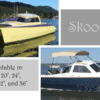
Cat 22 Boat Plans (CT22)
[CT22] Boat plans for a 22′ modern catamaran for twin outboards.
Description
Additional information.
- Reviews (0)
This design sat on our drafting table for almost 20 years. It started with somebody showing me the lines of a cat used by the Australian Coast Guard and asking for an epoxy-plywood version. We did not go very far. A catamaran cost more in material and labor than a monohull and after a quick estimate, the project went on the back burner.
Over the years, the same request came back regularly and as many of our builders have proven that they can successfully tackle elaborate projects, I went back to the drawing board and here is the result, our Cat 22 (CT22).
Click here to see study plans
Related kits:, cnc kit – marinepoxy kit – silvertip epoxy kit.
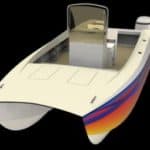
There are no reviews yet.
Your email address will not be published. Required fields are marked *
Your review *
Name *
Email *
Save my name, email, and website in this browser for the next time I comment.
You may also like…
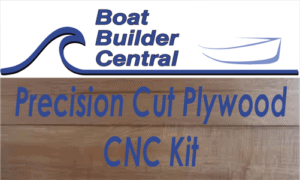
Cat 22 CT22-CNC Kit
- $ 8,627.90
- Add to cart

Pettit EZ-Poxy Topside Paint Performance Enhancer, 8 oz.
- $ 31.05

SilverTip Epoxy-Fiberglass Kit Cat 22 (CT22)
- $ 5,544.72
- Select options
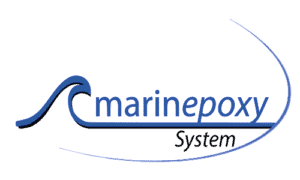
MarinEpoxy-Fiberglass Kit Cat 22 (CT22)
- $ 4,156.00

Pettit EZ-Poxy Polyurethane Topside Finish Gallons
- $ 148.60 – $ 162.73
Privacy Overview

- Plans & Kits
- Plans by type
ECO 55 Power Cat Plans
Write a review.

- Create New Wish List
Description
Additional information.

The ECO 55 power catamaran is an affordable DIY power catamaran. As the owner proved the boat is a capable coastal cruiser. The inside layout is the same as for the ECO55 sail version but the underwater shape is changed. The cockpit is wider and has a size of 1,45m x 2 m. With the bigger size normal deck chairs can be used. With a cockpit cover two more can sleep on the boat.
Accommodation is simple but practical.

Because of the easily driven hulls the boat will travel at about 12 knots with the a 15 HP outboard engine. But practice showed that a single outboard of 20 HP is more feasible - less noise and lower operating costs.

The boat has a double bunk, but the cockpit is big enough to sleep 2 more persons. The construction and list of materials is similar to the ECO55 sail version . The difference is that you need no rig, rudders or dagger board. With the low weight of about 325 kg including engines the boat can be towed behind a relative small car.

Construction is as always the plywood/glass/Epoxy construction system. The hulls are V-shaped with vertical sides - easy to build by a beginner. For cost estimation see the list of materials below.
- All drawings are CAD drawings
- Wood/epoxy composite for easy construction and low maintenance.
- Sleeps up to four
DELIVERY: 16 Drawings: JPG or DXF files. + Manual: 12 pages description (PDF)

Related Products

ECO 75 Power Cat Plans

ECO 55 Sail Plans

New ECO 55 Sail Plans

Skoota 18 Power Cat Plans PDF
- CruiseMapper
ACL American Legend deck plans
Deck layouts, review of facilities, activities, amenities.
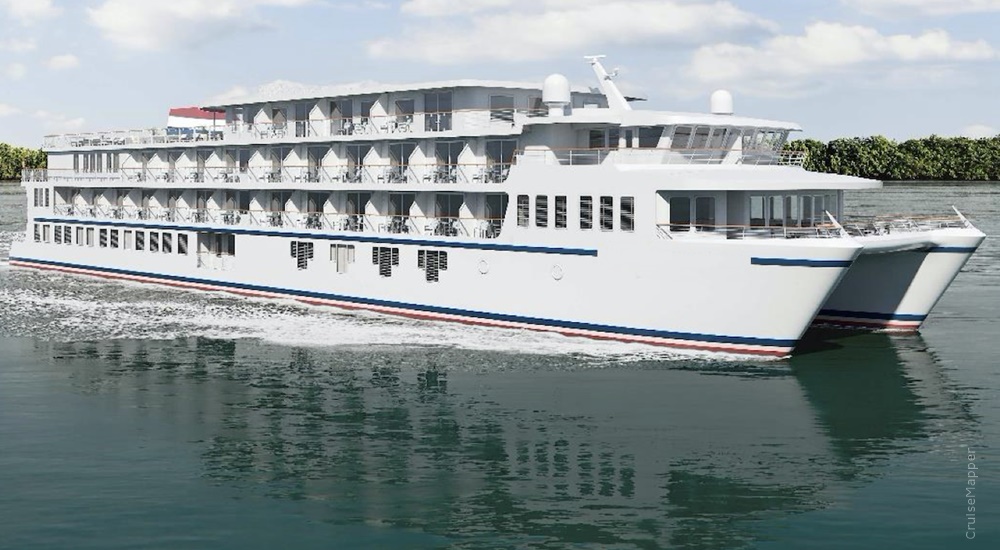
ACL American Legend deck plan review at CruiseMapper provides newest cruise deck plans (2024-2025-2026 valid floor layouts of the vessel) extracted from the officially issued by American Cruise Lines deckplan pdf (printable version).
Each of the ACL American Legend cruise ship deck plans are conveniently combined with a legend (showing cabin codes) and detailed review of all the deck's venues and passenger-accessible indoor and outdoor areas. A separate link provides an extensive information on ACL American Legend staterooms (cabins and suites), including photos, cabin plans and amenities by room type and category.
MS American Legend (2024-built) is the fourth "Coastal Cat" in a 12-unit series by ACL-American Cruise Lines ' "Project Blue". This new for ACL "catamaran ship" class is represented by 12 same-designed sisterships launched two units per year - 2023 ( Eagle , Glory ), 2024 ( Liberty , Legend), 2025, 2026, 2027, and 2028.
American Legend cruise ship deck plan shows a total of 56 staterooms for 109 passengers served by 50 crew/staff. The boat has 5 decks (4 with cabins, accessible via 2 elevators/midship lifts and stairs), 1 Dining Room (Restaurant and Kitchen), 2 indoor bar lounges (both with access to an outdoor terrace/forward and stern), an open-floor design Vestibule (4-deck Atrium with SkyLight/glass roof cover), Gym/Fitness Center, Games Room, Laundry Room, Pilothouse/Wheelhouse, Sun Deck (sunbathing and shaded seating areas, walking lane/track, live plants, 4x funnels/smokestacks), Helideck (deck 5).
Deck layouts
Deck 01 - cabins-lobby-restaurant-crew, deck 02 - cabins-lounge-gym, deck 03 - cabins-lido-bridge, deck 04 - suites-sundeck, deck 05 - helideck.
ACL American Legend deck plans are property of American Cruise Lines . All deck layouts are for informational purposes only and CruiseMapper is not responsible for their accuracy.
- Aluminum Boat Plans
35 FT Catamaran Workboat (616)

This design (plan) is a 35 FT aluminum catamaran. Power is two (2) Volvo D4-225 DP I/O at 189 HP each.
Gross weight and speed dependent on final arrangement.
*The above price is for the construction plans and a onetime use of the CAD cutting files.
Weight in table above is the weight of the uncut aluminum sheet and plate.
Stock hull is the flush deck shown on the included PDF drawing. Cabin and bullwork are available options.
Cabin and bullwork is not included in the aluminum sheet and plate weight calculations.
Please use a modern browser to view this website. Some elements might not work as expected when using Internet Explorer.
- Landing Page
- Luxury Yacht Vacation Types
- Corporate Yacht Charter
- Tailor Made Vacations
- Luxury Exploration Vacations
- View All 3585
- Motor Yachts
- Sailing Yachts
- Classic Yachts
- Catamaran Yachts
- Filter By Destination
- More Filters
- Latest Reviews
- Charter Special Offers
- Destination Guides
- Inspiration & Features
- Mediterranean Charter Yachts
- France Charter Yachts
- Italy Charter Yachts
- Croatia Charter Yachts
- Greece Charter Yachts
- Turkey Charter Yachts
- Bahamas Charter Yachts
- Caribbean Charter Yachts
- Australia Charter Yachts
- Thailand Charter Yachts
- Dubai Charter Yachts
- Destination News
- New To Fleet
- Charter Fleet Updates
- Special Offers
- Industry News
- Yacht Shows
- Corporate Charter
- Finding a Yacht Broker
- Charter Preferences
- Questions & Answers
- Add my yacht
WHISPER Yacht Layout & GA Plans
95.2m / 312'4 lurssen 2014.
- Previous Yacht
- Amenities & Toys
- Rates & Regions
- + Shortlist
Use two fingers to move the deck plan
Use ctrl + scroll to zoom the deck plan
Use ⌘ + scroll to zoom the deck plan
Zoomable Deck Plans Instructions To view the yacht General Arrangement / Deck Plans in more detail use the Zoom Tools + / - buttons to 'zoom in' or ' zoom out'. To navigate around hold down you mouse and drag to look around or for touch use two fingers to pinch and drag. To zoom with the mousewheel hold CTRL/⌘ and use the mouse wheel or use two fingers to scroll on an Apple touch pad.
SIMILAR YACHTS FOR CHARTER
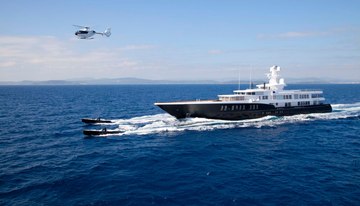
81m | Feadship
from $1,002,000 p/week ♦︎

78m | Abeking & Rasmussen
from $770,000 p/week
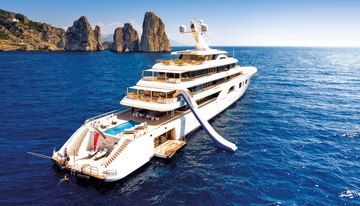
92m | Feadship
from $1,500,000 p/week
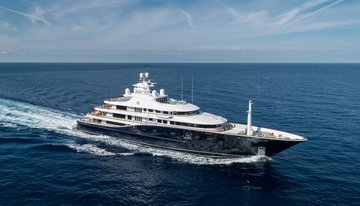
86m | Derecktor Shipyards
from $945,000 p/week
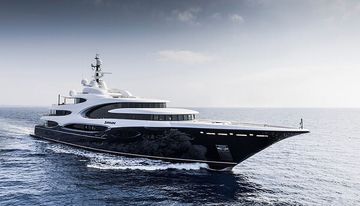
89m | Oceanco
from $1,100,000 p/week

90m | Oceanco
from $1,300,000 p/week ♦︎
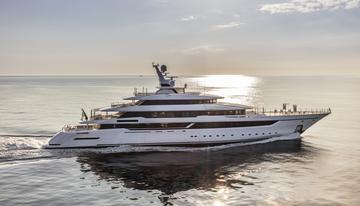
80m | Columbus Yachts
from $921,000 p/week ♦︎

80m | Yachtley
from $867,000 p/week ♦︎
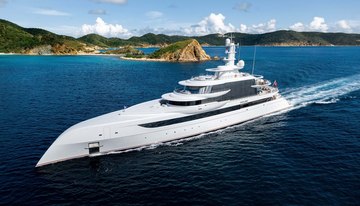
80m | Abeking & Rasmussen
from $1,150,000 p/week
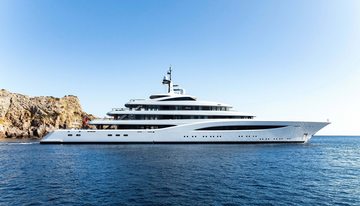
97m | Feadship
from $1,733,000 p/week ♦︎
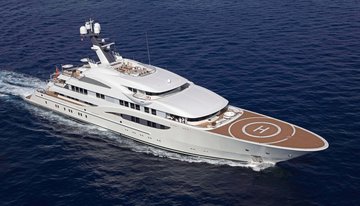
85m | Lurssen
from $0 p/week ♦︎
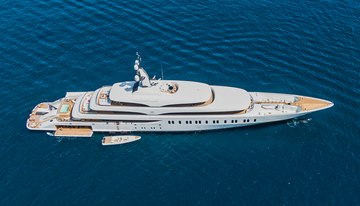
108m | Benetti
from $1,950,000 p/week ♦︎
NOTE to U.S. Customs & Border Protection
Charter Whisper
To charter this luxury yacht contact your charter broker or
SIMILAR LUXURY CHARTER YACHTS
Here are a selection of yachts which are similar to the current charter yacht. To view all similar luxury charter yachts click on the button below.

As Featured In
The YachtCharterFleet Difference
YachtCharterFleet makes it easy to find the yacht charter vacation that is right for you. We combine thousands of yacht listings with local destination information, sample itineraries and experiences to deliver the world's most comprehensive yacht charter website.
San Francisco
- Like us on Facebook
- Follow us on Twitter
- Follow us on Instagram
- Find us on LinkedIn
- Add My Yacht
- Affiliates & Partners
Popular Destinations & Events
- St Tropez Yacht Charter
- Monaco Yacht Charter
- St Barts Yacht Charter
- Greece Yacht Charter
- Mykonos Yacht Charter
- Caribbean Yacht Charter
Featured Charter Yachts
- Maltese Falcon Yacht Charter
- Wheels Yacht Charter
- Victorious Yacht Charter
- Andrea Yacht Charter
- Titania Yacht Charter
- Ahpo Yacht Charter
Receive our latest offers, trends and stories direct to your inbox.
Please enter a valid e-mail.
Thanks for subscribing.
Search for Yachts, Destinations, Events, News... everything related to Luxury Yachts for Charter.
Yachts in your shortlist
US/CAN Toll-Free
877 355 2034
127 325 1860.
- Expeditions
- Check Availability
ENDEMIC DECK PLANS
Comfort and safety.
The M/C Endemic features three decks fully dedicated to our passengers’ comfort and safety
Main Deck features: Front observation platform and briefing area on the bow. Four private, spacious, panoramic suites with their own balconies. Elegant and functional interior dining room and lounge with panoramic views of the islands. In the stern, there are two non-slip platforms to access the catamaran, a reception area, a snack counter, a storage room for expedition gear, an area to freshen up, and a water refill station.

Specifications
Suite Size (including balcony): 32 mt2/ 344 ft2
Golden Suite location: 4 suites – Main Deck
Panoramic Suites
Social areas.

Access & Reception Area
Embarkation and disembarkation platform Easy non-slip access to the catamaran. Reception and meeting point for daily guided excursions.
In our reception area, our guests receive snacks, drinks, and hot and cold towels after our visits to the islands. Wetsuits, snorkeling and expedition gear are stored here.

Internal Stairway – Access to the upper deck
The Endemic features an internal stairway for the enhanced safety of our guests and immediate access to our upper deck suites and outdoor terraces.

Matrimonial
Four suites located on the main deck, all of which boast panoramic views of the islands through their wall-to-wall, floor-to-ceiling sliding glass doors. Each suite also features a private balcony with a comfortable, welcoming seating area.

All Suites are convertible. We can accommodate our guests in two separate twin beds or a single king-size bed. Every suite has a sofa bed for additional bedding and extra space.

Panoramic living and dining rooms
On the main deck at the stern of the vessel, we have modern, carefully designed interior spaces such as panoramic dining and living areas, a 24-hour coffee and snack station, and an indoor bar.
The staff is courteous and professional, and the chef somehow sends one masterpiece after another out of the kitchen.

A spacious briefing area and information center at the bow of the catamaran is where lectures are given and where the workstation of our Cruise Service Officer is located.
We are proud to offer stylish social areas on the Endemic for our guests’ enjoyment: Panoramic views of the islands, delicious and authentic food, and unparalleled attention to detail.
The upper deck of the Endemic features a shaded terrace at the stern of the vessel for wildlife observation and private arrangements. It also hosts a sun terrace with sweeping navigation views of the islands. Four more panoramic suites are located on this deck, and interconnection between suites is possible for families or small groups. At the bow of the Endemic, there is also a sun terrace that is ideal for relaxing and enjoying the archipelago’s otherworldly landscapes. Private settings for guests with special demands or passengers celebrating an important occasion are arranged on our terrace.

- Golden Suites: 4 suites – Upper Deck
- Connecting Suites | Size (including balcony): 32 mt2/ 344 ft2
- Single cabin location: 1 cabin – Upper Deck
- Single cabin size (including balcony): 14 mt2/ 151 ft2

The primary difference between these suites and those on the main deck is that upper deck suites can interconnect- there’s a door that connects suites.

Single Cabin
A perfect complement for group accommodations onboard the ship is its single cabin. This cabin is little smaller than regular suites, but it still features a private balcony and all standard suite amenities.

A front-view sun terrace and an observation platform are located on the upper deck for extra space to admire the beauty of the islands and to relax in between excursions.
The Sky Deck is widely known as the most beautiful area on the ship. Our passenger sky lounge features al-fresco dining, a whirlpool and a leisure area, outdoor bar and food counter. After snorkeling, you can take a dip in our whirlpool and enjoy a drink or a snack in this beautiful shaded area. Spacious seating areas and sun chairs, a BBQ station, restrooms, and a food elevator for warm and fresh meals are part of the Sky Deck, and it goes without saying that amazing views and sunsets are a fixture!

Al-fresco dining
The shaded area of the sky deck allows guests to enjoy warm and fresh meals for breakfast, lunch or dinner. Meals are brought up to the deck via a food elevator straight out of our kitchen, and is complemented with our outdoor cocktail service.

The whirlpool on the sky deck has a comfortable seating area for sunbathing, relaxing, and simply enjoying your cruise. The whirlpool is prepared upon request during excursions and should be requested form our Cruise Service Officer.

Wildlife watching
Our sky lounge has plenty of space to capture the beauty of the islands and their wildlife. You can also enjoy a drink in the whirlpool while getting ready for your next meal, watching the exotic Galapagos birds fly alongside the Endemic.

IMAGES
VIDEO
COMMENTS
The first step is to decide on the design and the materials you will use. You will need plans for the project, along with lumber and other materials such as fiberglass and epoxy. The next step is to build the catamaran frame, which involves cutting and fitting the wood pieces together to form the hulls and decks.
If you were to build a 40-foot (12.1-meter) catamaran, your cost of materials would range between 20-30% of the total cost. Therefore, for $300,000 total, the boat's materials would range between $60,000 and $90,000. The hull tends to range between 15-35% of the total build.
The DESIGNER'S book TRIMARAN and CATAMARAN CONSTRUCTION is part of the plans (over 21') and covers all phases of construction. Plans are leased to build ONE boat, NO time limit. ... quick sailing catamaran with comfortable accomodations, a spacious bridge deck lounge area that has 6ft of headroom. Click for more information. TRI-STAR CAT 34 ...
The Prismatic Coefficient (Cp), a measure of how full the ends of the hull get, is the most essential design hull shape factor for any catamaran. A high Cp equals high speeds, although you can still use a lower Cp if you have fine hulls. Nevertheless, the key to a good Catamaran design is a higher Cp for fast sailing.
We provide stock boat plans for both monohull and multihull sailing vessels, including sailing skiffs and sharpies. Our designs mainly feature timber construction, in plywood or cedar strip plank composite construction, using the W.E.S.T. system (wood epoxy saturation technique). Our designs are intended mainly as cruising boats, although ...
Purchase Plans. This easy to build catamaran is intended to allow anyone, no matter their background, to build a modern cruising multihull with a thrilling performance and an appealing design with a small budget. The Bora-Bora 28 has a very practical interior lay-out with accommodation inside the hulls and a large platform to be used as a sundeck.
Privilege Completed Deck. For catamarans, the integral bridgedeck structure doesn't lend itself to a step-wise assembly. The crossbeams and bridgedeck need to be built integrally before the interior and decks are completely finished. For the builder, this means some parts of the boat have to be finished with reduced access to interior ...
Materials and Tools Needed for Building a Catamaran. Building a catamaran requires a variety of materials and tools. The materials you will need will depend on the design of your catamaran and the type of construction you choose. Common materials used in catamaran construction include wood, fiberglass, composites, aluminum, and PVC.
Order the Latest Design Portfolio today to see over 85 multihull plans in stock.Besides illustrating my stock designs, for which I sell study plans and full construction plans, it also contains my design philosophy of multihulls; an article on the rapid Cylinder Mold(pdf) or Cylinder-molding (in html) multihull construction; examples of drawing sets; photographs; fact sheets with dimensions ...
Bridgedeck catamarans are ideal for cruisers or liveaboard sailors. These vessels feature ample payload-carrying capacity and provide good protection for the crew. Helm locations are usually behind the coach roof bulkhead or in some rare cases on the aft end of the hulls behind the cockpit.
Suites Size: 35 mt 2 / 377 ft 2 - 37 mt 2 / 398 ft 2. Golden Suites location: 4 suites - Main Deck. Social Areas. Panoramic Suites. Dining and living rooms. At the stern of the Elite, there are two access doors to the interior panoramic guest lounge and dining areas. Meals are always made using fresh, locally sourced ingredients from farms ...
LOA: 15'-6"; LWL : 13'-9"; Beam: 6'-11"; Draft: 10". Weight of structure: 450 Lbs. Materials: Marine plywood, epoxy. Maximum capacity: 8 persons. The Flat Cat hull is a new and efficient concept and is within the capabilities of many amateurs to build. The hull is a "false" catamaran with a tunnel that's partially immersed.
Part 2 of a HH 66 multi-part series Hudson Yacht Group's faster than the wind Carbon Fiber Performance Cruising Cat. This is a thorough video series encompas...
POWER CATAMARAN PLANS and KITS, CATAMARAN PLANS , Bruce Roberts WEB SITE offers catamaran boat plans and catamaran boat kits for fiberglasss and aluminum boat designs, cut to size CATAMARAN kits, part built boats or complete boats. Bruce Roberts Yacht Designs offer boat building project management arrangements for boats built overseas at affordable prices.
The SC formula will inevitably illustrate that a wider beamed catamaran with a tall sail plan will be as resistant to wind induced capsize as a short-rigged, narrower boat. ... the formation of wave crests can pound the bridge deck. Most early narrow-beamed catamarans suffered from this phenomenon, Ultimately, a boat's design has a major ...
Cat 22 Boat Plans (CT22) [CT22] Boat plans for a 22′ modern catamaran for twin outboards. $ 325.00 - $ 350.00. Select Format. Choose an option Clear. SKU: CT22-plans Category: Power Cat Boat Plans. Description. Additional information.
In contrast to a monohull, the catamaran has two hulls that are connected by crossbeams. Located in the hulls are the staterooms, each with their own private head. The deckhouse and the bridge deck are used as the saloon and galley, and for navigating. Some catamarans even feature another level known as the fly bridge.
ECO 55 Power Cat Plans. The ECO 55 power catamaran is an affordable DIY power catamaran. As the owner proved the boat is a capable coastal cruiser. The inside layout is the same as for the ECO55 sail version but the underwater shape is changed. The cockpit is wider and has a size of 1,45m x 2 m. With the bigger size normal deck chairs can be used.
MS American Legend (2024-built) is the fourth "Coastal Cat" in a 12-unit series by ACL-American Cruise Lines' "Project Blue". This new for ACL "catamaran ship" class is represented by 12 same-designed sisterships launched two units per year - 2023 (Eagle, Glory), 2024 (Liberty, Legend), 2025, 2026, 2027, and 2028.American Legend cruise ship deck plan shows a total of 56 staterooms for 109 ...
Here are a selection of superyachts which are similar to Pegasus IX yacht which are believed to be available for charter. To view all similar luxury charter yachts click on the button below. Interactive, detailed layout / general arrangement of PEGASUS IX, the 27m Sabre Catamarans super yacht with naval architecture by Sabre Catamarans.
35 FT Catamaran Workboat (616) This design (plan) is a 35 FT aluminum catamaran. Power is two (2) Volvo D4-225 DP I/O at 189 HP each. Gross weight and speed dependent on final arrangement. The above price is for the construction plans and a onetime use of the CAD cutting files. Hull 616.
Zoomable Deck Plans Instructions To view the yacht General Arrangement / Deck Plans in more detail use the Zoom Tools + / - buttons to 'zoom in' or ' zoom out'. To navigate around hold down you mouse and drag to look around or for touch use two fingers to pinch and drag.
ENDEMIC DECK PLANS Comfort and Safety The M/C Endemic features three decks fully dedicated to our passengers' comfort and safety MAIN DECK Main Deck features: Front observation platform and briefing area on the bow. ... Endemic Galapagos Luxury Mega Catamaran; Deck Plans; Deck Plans goldengalapagoscruises 2024-02-07T10:37:57-05:00. Overview ...